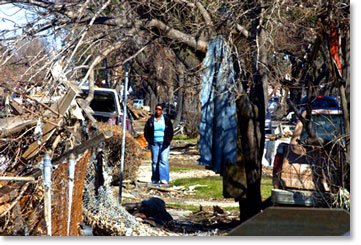FCNNEWSSOURCE

Hearkening back to the times when the entire family would sit captivated watching the Roots series broadcast on television, Spike Lee’s latest contribution to films that define our history is must-see TV.
Originally airing in two parts August 21-22, his four-hour HBO documentary, When The Levees Broke: A Requiem in Four Acts, is an expansive exploration of the spectrum of emotions, facts, reports and events leading up to and a year following Hurricane Katrina making landfall Aug. 29, 2005 in the Gulf Coast area. Spike Lee is brilliant and his film is an epic artistic collage of music and mayhem; desperation and dignity; loss and love; indignation and inspiration.
From residents recalling the first hours of impact–like a “freight train in your ears for hours”–to the photo montage of abandoned corpses scattered across water and land to researchers examining the city’s flawed flood protection, the devastation and suffering that followed the breaching of the levees is painstakingly chronicled in indelible stories.
Who will forget the lisping tongue of a Black boy, shaking his head, pleading for insulin for his grandmother? “It is children out here,” he declared. “We just need some help and some support.” Who will forget a man recounting having to push in a corner his mother who died in a wheelchair at his side, leaving a note in her hands to identify her? Who will forget the recollections of the hot and sweaty days inside the filthy Superdome without running, disposable water, with women emerging from the sewer-like conditions with their periods having come down on them or feces and urine on their clothes? Who will forget the walk residents traveled through the darkness of the Dome, clapping and singing, “This Little Light of Mine” when hope was becoming as faint as their breath? “You only had faith in God,” a resident says, “and you gave God the glory.”
Equally poignant and sharp are the criticisms of the local communication breakdown, federal vs. state authority showdown and engineering let-down. Neither the oil business, FEMA or Condoleezza Rice are spared blame. “Blahniks, Broadway and balls are more important than Black people that look like her… a woman from Birmingham,” Dr. Michael Eric Dyson remarks about Condi’s days of shopping for shoes, going to a show and playing tennis when the floodwaters first immersed New Orleans.
Taking nine visits to New Orleans to complete the film, interviewing over 80 people, Spike Lee presents the colossal struggle to recover and rebuild, whether residents return to their beloved ravaged city or embrace the new life in their city of displacement. Distraught resident Gina Montana reminds us in her interview that when she grew up, New Orleans was not called The Big Easy, but rather The City That Care Forgot.
And like the echoes of jazz dirges filtering through the streets of New Orleans during funeral marches, the underlying truth of her words resonate in our hearts: That none of us can afford to forget.
Remember Katrina.












